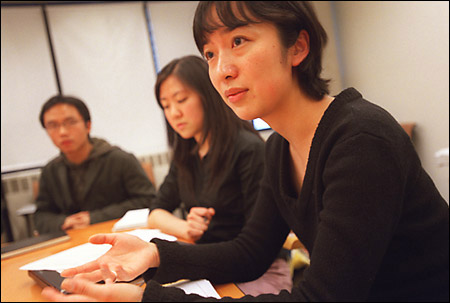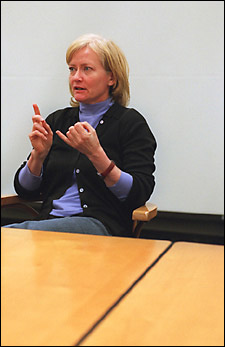GSD students win tsunami design award
Devise strategy for development, permanent housing

A group of students at the Graduate School of Design (GSD) have won a competition to design permanent housing for survivors of the December 2004 tsunami disaster.
The Special Interest Group in Urban Settlement (SIGUS) at the Massachusetts Institute of Technology hosted the competition, which was titled “The Tsunami Challenge: After the Tent.” Open to designers in the Cambridge area, the competition targeted the phase after immediate disaster needs have been addressed and more permanent housing and development strategies are called for.
The five students – Ellen Chen, Eric Ho, Nour Jallad, Rick Lam, and Ying Zhou – all from the master of architecture program, had been meeting to discuss ways in which they could help with the relief effort. When they heard about the competition, they realized it was an opportunity to use their design skills to help the tsunami survivors.
“There have been a lot of lessons from the tsunami that can be used in rebuilding the infrastructure,” said Zhou. “It’s an opportunity to try out new designs, but also to really help people. We as students should be engaged in that.”
Calling themselves the Tsunami Design Initiative (TDI), the students began by attending a special workshop at MIT at which representatives from Southeast Asian organizations and other experts spoke about the special needs of the area and the constraints under which designers would have to work.

They supplemented the briefings by conducting extensive research on their own in order to learn as much as they could about the geography, climate, economic conditions, ethnic and religious makeup, and natural environment of the region. They decided to focus on Sri Lanka because it is small in size and relatively well organized, yet more in need of help than some of the other countries affected.
None of the students had ever visited Sri Lanka, but the thoroughness with which they conducted their research became obvious when they presented their designs to the judges of the competition.
“People who had been to Sri Lanka were asking them how long they’d been working there,” said Associate Professor of Architecture Michelle Addington, who served as the design team’s faculty adviser. “They were all stunned by the depth of the students’ knowledge.”

But the students’ entry did more than simply demonstrate the extent of their knowledge of the Sri Lankan coastal area whose infrastructure they hope to rebuild. It also presented some highly innovative ideas for creating flexible, culturally sensitive structures while also providing greater protection against similar disasters in the future.
The team’s entry, called “A Framework for Managing Design,” is organized around the concept of discrete building cores – three-sided structures made of concrete or brick, 10 feet long by 4 1/2 feet wide. Anchored to concrete foundations, these cores enclose the kitchen, bathroom, and storage spaces.
Once the cores are in place, community members would build structures around them, using traditional designs and materials. In the event of another tsunami, the concrete cores would provide protection from the destructive force of the water and provide an underlying structure around which houses could be rebuilt.
“The idea was not only to design houses, but to anticipate how the community can grow. The core can be adapted to different configurations, shapes, and materials,” said Ho.
The Harvard team, along with other students from MIT and the Rhode Island School of Design who had entered the competition, was invited to travel to Washington, D.C., to present their ideas to the Office of Foreign Disaster Assistance of the United States Agency for International Development. Representatives from various nongovernmental organizations were also on hand to hear the students’ ideas. The Harvard students’ trip was paid for by GSD alumnus Steven Plofker ’80.
The students are hoping to raise money for a visit to Sri Lanka this summer where they plan to gather more information about local conditions and customs that will help them further refine their designs. They also hope to see prototypes of a house and a community center based on their ideas that are being built by the Prajnopaya Foundation, a Buddhist organization dedicated to service and education.
“The visit to Sri Lanka may lead to a publication or an exhibition at the Design School,” said Ho.




